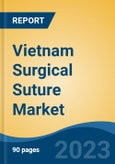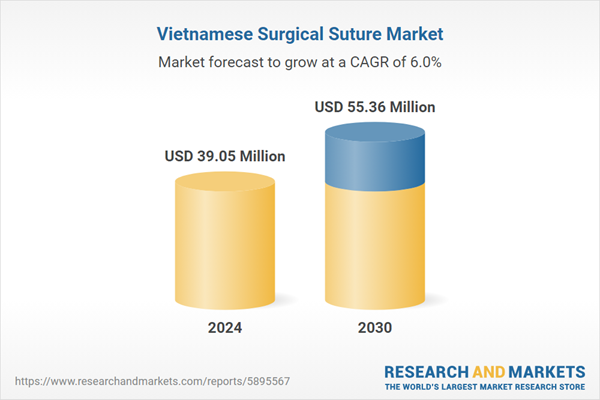Speak directly to the analyst to clarify any post sales queries you may have.
10% Free customizationThis report comes with 10% free customization, enabling you to add data that meets your specific business needs.
The material of the suture is chosen according to its compatibility with the tissue being sutured. Some tissues require sutures that minimize irritation or inflammation, while others demand stronger sutures for structural support during healing. There are also specialized sutures for distinct surgical applications; for instance, sutures used in cardiovascular surgery differ from those used in ophthalmic surgery. Such tailored solutions meet the specialized needs of each surgical specialty.
Key Market Drivers
Technological Advancements in Sutures
Ongoing technological advancements in surgical sutures have led to the creation of more efficient, biocompatible, and specialized products. These innovations aim to enhance patient outcomes, minimize complications, and improve the overall surgical experience. Absorbable sutures, for example, break down and are naturally absorbed by the body, eliminating the need for removal and reducing the risk of infection and patient discomfort. Materials such as polyglycolic acid (PGA), polylactic acid (PLA), and polydioxanone (PDO) are used to create absorbable sutures. Sutures may be monofilament (single-stranded) or multifilament (comprising multiple strands). Monofilament sutures are smoother, causing less tissue trauma and lowering the risk of infection, while multifilament sutures offer superior handling characteristics.Barbed sutures, which feature backward-facing barbs or notches, enable easier and more secure tissue approximation, making them ideal for minimally invasive procedures, and eliminating the need for knots. Antimicrobial-coated sutures, treated with agents like triclosan or chlorhexidine, are crucial in reducing the risk of surgical site infections, particularly in high-risk surgeries.
Key Market Challenges
Intensified Competition
The market faces significant competition, which often leads to price pressure as manufacturers strive to offer competitive pricing. This competitive environment can result in lower profit margins for suture manufacturers. To remain competitive, companies must continuously invest in research and development to drive innovation and differentiate their products. This ongoing commitment to product enhancement comes at a substantial cost.Differentiating suture products in a crowded market can be challenging, as many products fulfill similar roles. Manufacturers must find ways to add distinctive features or benefits to their offerings. Effective marketing and sales strategies are also essential for engaging healthcare providers and facilities, particularly as competition intensifies. Healthcare institutions, with their purchasing power, may negotiate pricing and terms, potentially affecting manufacturers’ profitability. In certain regions or product segments, market saturation can make it difficult for new entrants or smaller manufacturers to establish a presence, while larger companies may consolidate their positions through mergers and acquisitions, further complicating the competitive landscape for smaller players.
Key Market Trends
Increased Demand for Minimally Invasive Surgery (MIS)
The demand for minimally invasive surgery (MIS) has driven the need for specialized sutures designed for these procedures. These sutures are typically smaller in size, offer greater flexibility, and incorporate features that facilitate suturing in tight or confined spaces. As MIS becomes more prevalent, the market for sutures tailored for these procedures is expanding. Minimally invasive surgeries are associated with reduced tissue trauma, smaller incisions, less pain, and quicker recovery times compared to traditional open surgeries.Surgical sutures are essential in ensuring proper wound closure, optimal healing, and minimizing complications following these procedures. Patients undergoing minimally invasive surgeries typically experience shorter hospital stays and faster recovery, which is contributing to the overall increase in demand for sutures in these types of surgeries. The growth of laparoscopic and robotic-assisted surgeries, which require specialized suturing materials and techniques, further boosts demand in the surgical suture market. Minimally invasive procedures are also commonly used in cosmetic and aesthetic surgeries, such as facelifts and liposuction, where precise suturing is critical for achieving aesthetically pleasing results.
Key Market Players
- CPT Sutures Co., Ltd.
- USM Healthcare
- Medical Devices and Biomaterial Plant Joint Stock Company (MEDEP)
- Medtronic Vietnam
- Johnson & Johnson Vietnam
- Stryker Vietnam
- B.Braun Vietnam Co., Ltd.
- Smith & Nephew Vietnam
- Pinnacle Health Co., Ltd.
Report Scope:
In this report, the Vietnam Surgical Suture Market has been segmented into the following categories, in addition to the industry trends which have also been detailed below:Surgical Suture Market, By Type:
- Automated Suturing Devices
- Suture Thread
Surgical Suture Market, By End User:
- Hospitals & Clinics
- Ambulatory Care Centers
- Others
Vietnam Surgical Suture Market, By region:
- Northern Vietnam
- Southern Vietnam
- Central Vietnam
Competitive Landscape
Company Profiles: Detailed analysis of the major companies present in the Vietnam Surgical Suture Market.Available Customizations:
With the given market data, the publisher offers customizations according to a company's specific needs. The following customization options are available for the report.Company Information
- Detailed analysis and profiling of additional market players (up to five).
This product will be delivered within 1-3 business days.
Table of Contents
Companies Mentioned
- CPT Sutures Co., Ltd.
- USM Healthcare
- Medical Devices and Biomaterial Plant Joint Stock Company (MEDEP)
- Medtronic Vietnam
- Johnson & Johnson Vietnam
- Stryker Vietnam
- B.Braun Vietnam Co., Ltd.
- Smith & Nephew Vietnam
- Pinnacle Health Co., Ltd.
Table Information
| Report Attribute | Details |
|---|---|
| No. of Pages | 83 |
| Published | April 2025 |
| Forecast Period | 2024 - 2030 |
| Estimated Market Value ( USD | $ 39.05 Million |
| Forecasted Market Value ( USD | $ 55.36 Million |
| Compound Annual Growth Rate | 5.9% |
| Regions Covered | Vietnam |
| No. of Companies Mentioned | 9 |









